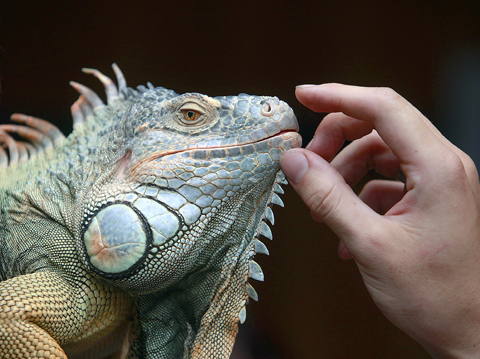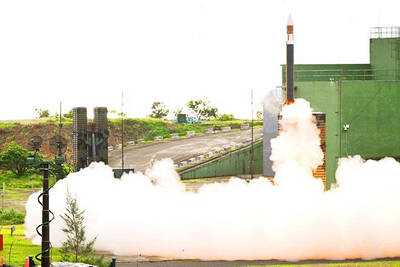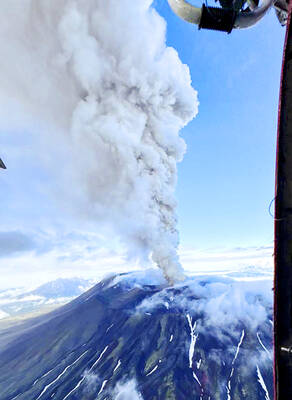Brute, a German shepherd, lay anesthetized on an operating table, his hairy chest under a plastic cover and his powerful paws taped immobile.
“Here comes the wire up the artery,” said veterinarian Chick Weisse, who infused the dog’s cancerous liver with chemotherapy via a catheter at the century-old Animal Medical Center (AMC) in Manhattan in an effort to “buy him some time.”
Brute was home in days, the cancer at bay a while longer — perhaps eight months. The cost: US$2,000.

PHOTO: REUTERS
Around the US, veterinarians are practicing ever more advanced medicine on the US’ 77 million dogs, 90 million cats and a myriad of other animals, treatments that vie with the best of human medicine.
The driving force is “the changing role of the pet in our society,” said Patty Khuly, a veterinarian at Miami’s Sunset Animal Clinic.
The bottom line for many people, she said, is that investing in a pet’s life “improves the quality of a human life immeasurably more than, say, buying a luxury car.”
In a radiation suite at the AMC, a black cat named Muka was undergoing a CT scan for a lung problem. A medical team hovered over the tranquilized animal, injecting contrast dye and poring over digital readouts to diagnose the problem: chronic pleural fibrosis.
The new, US$500,000 Toshiba Aquilion, one of the latest, fastest 3-D imaging scanners, was a gift from an owner whose pet was saved at the AMC, a not-for-profit research and teaching facility.
The AMC offers 24-hour emergency care using once-unthinkable procedures like heart surgeries, MRIs and ultrasounds. It has a staff of 81 veterinarians, including 27 certified in fields such as radiology, endoscopy, neurology, cardiology and oncology.
They train 18 interns and 24 residents, including two from Italy and one from Croatia this year.
Khuly, who has an MBA and a veterinary degree from the University of Pennsylvania, says more people have come to believe that investing in their pets’ health enriches their own lives. And that, she says, has prompted young vets to enter specialty medicine.
The result is the kind of cutting-edge care the AMC gives to a mammoth Bernese mountain dog named Alpha for his lumbo-sacral disease, marked by excruciating back pain. He receives electrical neuromuscular stimulation via a light laser, is exercised on an underwater treadmill and lies under a heat pack.
Alpha comes in twice a week with his owner, Paul Greengard, winner of a 2000 Nobel Prize for research on the human nervous system.
Though many Americans do not get the kind of care their pets do, there are often no limits to what they will do to save the animals.
Americans spent US$12 billion last year paying veterinary bills, according to the American Society for the Prevention of Cruelty to Animals. That is about double what owners spent a decade earlier.
In some cases, advanced medicine perfected on pets leads to procedures then applied to humans.
The AMC says animals’ painful arthritic joints are now being healed with stem cell transplants not yet approved for humans. The cost: US$4,000.
At the University of Wisconsin-Madison School of Veterinary Medicine, a new surgical technique to repair torn knee ligaments in dogs was so successful that it is now being used on professional football players, said William Gengler, director of Wisconsin’s Veterinary Medical Teaching Hospital.
Wisconsin also pioneered treating cancers in animals with TomoTherapy, image-guided radiation that targets only the tumor and spares surrounding tissue. That is achieved by pinpointing the diseased tissue with a 360-degree CT scanner, then opening radiation windows precisely at the needed location, Gengler said.
TomoTherapy is now state-of-the-art treatment for people, with several hundred such machines being used worldwide on human cancers.
Among the recent pet beneficiaries was Scout, a soft-coated Wheaten terrier that belongs to a family in Mequon, Wisconsin.
Kathy Hrkac and her husband had bought the dog for their two daughters, “and he was a family member, full of life and love,” she said, until suddenly, about two years ago, blood started dripping from the five-year-old terrier’s nose and he had a hard time breathing.
The diagnosis: a quickly spreading nose cancer that left him with about one month to live.
“It was heart-wrenching,” Hrkac said in a telephone interview from her home.
Scout underwent TomoTherapy about a year and a half ago and it spared his mouth and eyes, which likely would have been damaged by conventional radiation, Gengler said.
The Wisconsin veterinary school at first shared a TomoTherapy machine with the university’s medical school. Private donations have funded a US$3 million unit opening in January — the first in a US veterinary facility, Gengler said.
He said a treatment like that for the Wisconsin terrier would now cost at least US$6,000, but at this veterinary hospital supported by academic grant money, the Hrkac family paid US$3,000.
In New York, the AMC sees about 40,000 patients each year, from dogs and cats to lambs, iguanas and a ring-tailed lemur, a primate native to Madagascar.
Some end up in the intensive care unit, with a soundtrack of beeping monitors surrounding stainless steel cages crisscrossed with tubes and wires.
Plexiglas cubicles are for creatures needing emergency oxygen.
Khuly said such sophisticated medicine is within reach thanks to pet insurance, payment plans offered by hospitals like AMC and interest-free credit cards for veterinary bills.
AMC also raises funds for owners whose animals might otherwise die because the owners cannot afford pricey treatments.
The most advanced pet medicine involves “high-tech procedures with highly qualified people performing them — and it’s expensive,” said Jennifer Fearing, chief economist for the nonprofit Humane Society of the United States in Washington, the world’s largest animal advocacy organization.
She said she does not feel pioneering veterinarians are overcharging for reaching to the edge of medical science.
Until such treatments become mainstream, with supporting insurance, says Fearing, owners can opt for effective, more affordable care that still saves lives.

Authorities have detained three former Taiwan Semiconductor Manufacturing Co (TMSC, 台積電) employees on suspicion of compromising classified technology used in making 2-nanometer chips, the Taiwan High Prosecutors’ Office said yesterday. Prosecutors are holding a former TSMC engineer surnamed Chen (陳) and two recently sacked TSMC engineers, including one person surnamed Wu (吳) in detention with restricted communication, following an investigation launched on July 25, a statement said. The announcement came a day after Nikkei Asia reported on the technology theft in an exclusive story, saying TSMC had fired two workers for contravening data rules on advanced chipmaking technology. Two-nanometer wafers are the most

NEW GEAR: On top of the new Tien Kung IV air defense missiles, the military is expected to place orders for a new combat vehicle next year for delivery in 2028 Mass production of Tien Kung IV (Sky Bow IV) missiles is expected to start next year, with plans to order 122 pods, the Ministry of National Defense’s (MND) latest list of regulated military material showed. The document said that the armed forces would obtain 46 pods of the air defense missiles next year and 76 pods the year after that. The Tien Kung IV is designed to intercept cruise missiles and ballistic missiles to an altitude of 70km, compared with the 60km maximum altitude achieved by the Missile Segment Enhancement variant of PAC-3 systems. A defense source said yesterday that the number of

A bipartisan group of US representatives have introduced a draft US-Taiwan Defense Innovation Partnership bill, aimed at accelerating defense technology collaboration between Taiwan and the US in response to ongoing aggression by the Chinese Communist Party (CCP). The bill was introduced by US representatives Zach Nunn and Jill Tokuda, with US House Select Committee on the Chinese Communist Party Chairman John Moolenaar and US Representative Ashley Hinson joining as original cosponsors, a news release issued by Tokuda’s office on Thursday said. The draft bill “directs the US Department of Defense to work directly with Taiwan’s Ministry of National Defense through their respective

Tsunami waves were possible in three areas of Kamchatka in Russia’s Far East, the Russian Ministry for Emergency Services said yesterday after a magnitude 7.0 earthquake hit the nearby Kuril Islands. “The expected wave heights are low, but you must still move away from the shore,” the ministry said on the Telegram messaging app, after the latest seismic activity in the area. However, the Pacific Tsunami Warning System in Hawaii said there was no tsunami warning after the quake. The Russian tsunami alert was later canceled. Overnight, the Krasheninnikov volcano in Kamchatka erupted for the first time in 600 years, Russia’s RIA